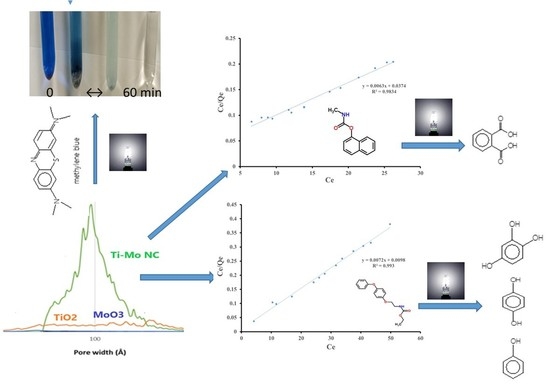Fabrication of High Surface Area TiO2-MoO3 Nanocomposite as a Photocatalyst for Organic Pollutants Removal from Water Bodies
Abstract
1. Introduction
2. Results and Discussion
3. Instrumentation
3.1. Chemicals
3.2. Synthesis of Ti-Mo NC
3.3. Methods
3.4. Photochemical Reaction Cell
4. Conclusions
Author Contributions
Funding
Data Availability Statement
Acknowledgments
Conflicts of Interest
References
- Dong, H.; Zeng, G.; Tang, L.; Fan, C.; Zhang, C.; He, X.; He, Y. An Overview on Limitations of TiO2-based Particles for Photocatalytic Degradation of Organic Pollutants and the Corresponding Countermeasures. Water Res. 2015, 79, 128–146. [Google Scholar] [CrossRef]
- Navgire, M.; Yelwande, A.; Tayde, D.; Arbad, B.; Lande, M. Photodegradation of Molasses by a MoO3-TiO2 Nanocrystalline Composite Material. Chin. J. Catal. 2012, 33, 261–266. [Google Scholar] [CrossRef]
- Khan, A.; Yuan, S.; Niu, S.; Zheng, L.; Li, W.; Zeng, H. Synthesis of Molybdenum Oxide-Titanium Dioxide Nanocompositeswith Ultrashort Laser Ablation in Water. Opt. Express 2017, 25, A539. [Google Scholar] [CrossRef]
- Konstantinova, E.; Minnekhanov, A.; Kokorin, A.; Sviridova, T.; Sviridov, D. Determination of the Energy Levels of Paramagnetic Centers in the Band Gap of Nanostructured Oxide Semiconductors Using EPR Spectroscopy. J. Phys. Chem. C 2018, 122, 10248–10254. [Google Scholar] [CrossRef]
- Li, N.; Li, Y.; Li, W.; Ji, S.; Jin, P. One-Step Hydrothermal Synthesis of TiO2@MoO3 Core-Shell Nanomaterial: Microstructure, Growth Mechanism, and Improved Photochromic Property. J. Phys. Chem. C 2016, 120, 3341–3349. [Google Scholar] [CrossRef]
- Natori, H.; Kobayashi, K.; Takahashi, M. Fabrication and Photocatalytic Activity of TiO2/MoO3 Particulate Films. J. Oleo. Sci. 2009, 58, 203–211. [Google Scholar] [CrossRef] [PubMed]
- Silvestri, S.; Kubaski, E.; Sequinel, T.; Pianaro, S.; Varela, J.; Tebcherani, S. Optical Properties of the MoO3-TiO2 Particulate System and its use as a Ceramic Pigment. Part Sci. Technol. 2013, 31, 466–473. [Google Scholar] [CrossRef]
- Yang, M.; Zhang, L.; Jin, B.; Huang, L.; Gan, Y. Enhanced Photoelectrochemical Properties and Water Splitting Activity of Self ordered MoO3-TiO2 Nanotubes. Appl. Surf. Sci. 2016, 364, 410–415. [Google Scholar] [CrossRef]
- Chithambararaj, A.; Bose, A. Hydrothermal Synthesis of Hexagonal and Orthorhombic MoO3 Nanoparticles. J. Alloys Compd. 2011, 509, 8105–8110. [Google Scholar] [CrossRef]
- Manivel, A.; Lee, G.; Chen, C.; Chen, J.; Ma, S.; Horng, T.; Wu, J. Synthesis of MoO3 Nanoparticles for Azo Dye Degradation by Catalytic Ozonation. Mater. Res. Bull. 2015, 62, 184–191. [Google Scholar] [CrossRef]
- Salari, H. Efficient Photocatalytic Degradation of Environmental Pollutant with Enhanced Photocarrier Separation in Novel Z-scheme a-MnO2 Nanorod/a-MoO3 Nanocomposites. J. Photochem. Photobiol. A Chem. 2020, 401, 112787. [Google Scholar] [CrossRef]
- Kubiak, A.; Wojciechowska, W.; Kurc, B.; Pigłowska, M.; Synoradzki, K.; Gabała, E.; Moszyński, D.; Szybowicz, M.; Siwińska-Ciesielczyk, K.; Jesionowski, T. Highly Crystalline TiO2-MoO3 Composite Material Synthesized via a Template-Assisted Microwave Method for Electrochemical Application. Crystals 2020, 10, 493. [Google Scholar] [CrossRef]
- Liu, K.; Huang, X.; Pidko, E.; Hensen, E. MoO3-TiO2 Synergy in Oxidative Dehydrogenation of Lactic Acid to Pyruvic Acid. Green Chem. 2017, 19, 3014–3022. [Google Scholar] [CrossRef]
- Wang, C.; Wu, L.; Wang, H.; Zuo, W.; Li, Y.; Liu, J. Fabrication and Shell Optimization of Synergistic TiO2-MoO3 Core-Shell Nanowire Array Anode for High Energy and Power Density Lithium-Ion Batteries. Adv. Funct. Mater. 2015, 25, 3524–3533. [Google Scholar] [CrossRef]
- Wang, Q.; Zhou, C.; Yan, X.; Wang, J.; Wang, D.; Yuan, X.; Cheng, X. TiO2 Nanoparticles Modified MoO3 Nanobelts as Electrode Materials with Superior Performances for Supercapacitors. Energy Technol. 2018, 6, 2367–2373. [Google Scholar] [CrossRef]
- Boboriko, N.; Bobrikov, I.; Lapchuk, N.; Sviridov, D. The Role of Structural Features in Heterogeneous Catalytic Oxidation of H2 on TiO2: MoO3 Nanocomposites. J. Solid State Chem. 2019, 275, 181–186. [Google Scholar] [CrossRef]
- Kokorin, A.; Sviridova, T.; Kolbanev, I.; Sadovskaya, L.; Degtyarev, E.; Vorobieva, G.; Treletskii, D. Structure and Photocatalytic Properties of TiO2/MoO3 and TiO2/V2O5 Nanocomposites Obtained by Mechanochemical Activation Russ. J. Phys. Chem. B 2018, 12, 330–335. [Google Scholar] [CrossRef]
- Lu, M.; Shao, C.; Wang, K.; Lu, N.; Zhang, X.; Zhang, P.; Zhang, M.; Li, X.; Liu, Y. P-MoO3 Nanostructures/n-TiO2 Nanofiber Heterojunctions: Controlled Fabrication and Enhanced Photocatalytic Properties. ACS Appl. Mater. Interfaces 2014, 6, 9004–9012. [Google Scholar] [CrossRef]
- Zhao, Y.; Sun, Q.; Luo, J.; Chen, H.; Cai, W.; Su, X. Hydrothermal Fabrication of TiO2-MoO3 Nanocomposites with Superior Performance for Water Treatment. Nano-Struct. Nano-Objects 2018, 13, 93–99. [Google Scholar] [CrossRef]
- Sari, F.; Yen, D.; Ting, J. Enhanced Photocatalytic Performance of TiO2 through a Novel Direct Dual Z-scheme Design. Appl. Surf. Sci. 2020, 533, 147506. [Google Scholar] [CrossRef]
- Ranade, M.; Elder, S.; Navrotsky, A. Energetics of Nanoarchitectured TiO2-ZrO2 and TiO2 MoO3 Composite Materials. Chem. Mater. 2002, 14, 1107–1114. [Google Scholar] [CrossRef]
- Tripathy, S.; Jo, J.; Wu, X.; Yoon, J.; Yu, Y. Synthesis and Photocatalytic Property of Metal@SnO2 Core-shell Structure Nanocomposites. J. Nanosci. Nanotechnol. 2011, 11, 453–457. [Google Scholar] [CrossRef] [PubMed]
- Liu, H.; Lv, T.; Zhu, C.; Zhu, Z. Direct Bandgap Narrowing of TiO2/MoO3 Heterostructure Composites for Enhanced Solar-Driven Photocatalytic Activity. Sol. Energy Mater. Sol Cells 2016, 153, 1–8. [Google Scholar] [CrossRef]
- Zhang, B.; Sun, S.; Shi, N.; Liao, X.; Yin, G.; Huang, Z.; Chen, X.; Pu, X. Spaced TiO2 Nanotube Arrays for Electrodeposition of MoO3 to Achieve High Electrochemical Performance. J. Alloys Compd. 2020, 820, 153066. [Google Scholar] [CrossRef]
- Yao, Y.; Sun, M.; Zhang, Z.; Lin, X.; Gao, B.; Anandan, S.; Liu, W. In Situ Synthesis of MoO3 /Ag/TiO2 Nanotube Arrays for Enhancement of Visible-light Photoelectrochemical Performance. Int. J. Hydrog. Energy 2019, 44, 9348–9358. [Google Scholar] [CrossRef]
- Amirhossein Alaghmandfard, A.; Ghandi, K. A Comprehensive Review of Graphitic Carbon Nitride (g-C3N4)–Metal Oxide-Based Nanocomposites: Potential for Photocatalysis and Sensing. Nanomaterials 2022, 12, 294. [Google Scholar] [CrossRef]
- Rui-Zhi Zhang, R.; Chen, Q.; Lei, Y.; Zhou, J. Growth of MoS2 nanosheets on TiO2/g-C3N4 nanocomposites to enhance the visible-light photocatalytic ability. J. Mat. Sci. Mat. Electron. 2019, 30, 5393–5403. [Google Scholar] [CrossRef]
- Ahern, J.; Kanan, S.; Sara, Z.; Job, T.; Alnaizy, R.; Abu Farha, N.; Patterson, H. Photocatalysis of Fenoxycarb over Silver-Modified Zeolites. Environ. Sci. Pollut. Res. 2015, 22, 3186–3192. [Google Scholar] [CrossRef]
- Kanan, S.; Malkawi, A. Mixed Silver–Zinc Encapsulated Zeolite-Y Powders Toward the Photodegradation of Aqueous Fenoxycarb Solutions. Desalin. Water Treat. 2017, 100, 281. [Google Scholar] [CrossRef]
- Kanan, S.; Moyet, M. Fabricated Metal Zeolites as Photocatalysts for the Degradation of Organic Pollutants. Res. Chem. Intermed. 2021, 47, 433–458. [Google Scholar] [CrossRef]
- Kanan, S.; Moyet, M.; Arthur, R.; Patterson, H. Recent Advances on TiO2-based Photocatalysts Toward the Degradation of Pesticides and Major Organic Pollutants from Water Bodies. Catal. Rev. 2020, 62, 1–65. [Google Scholar] [CrossRef]
- Kang, J.; Kim, J.; Lee, J.; Son, J.; Chung, Y.; Park, S.; Jeong, J.; Yoo, J.M.; Shin, H.; Choe, H.; et al. Electrochemically Synthesized Nanoporous Molybdenum Carbide as a Durable Electrocatalyst for Hydrogen Evolution Reaction. Adv. Sci. 2018, 5, 1700601. [Google Scholar] [CrossRef] [PubMed]
- Baltrusaitis, J.; Mendoza-Sanchez, B.; Fernandez, V.; Veenstra, R.; Dukstiene, N.; Roberts, A.; Fairley, N. Generalized Molybdenum Oxide Surface Chemical State XPS Determination via Informed Amorphous Sample Model. Appl. Surf. Sci. 2015, 326, 151–161. [Google Scholar] [CrossRef]
- Gao, Y.; Wu, X.; Ran, R.; Si, Z.; Ma, Z.; Wang, B.; Weng, D. Effects of MoOx on Dispersion of Vanadia and Low-Temperature NH3-SCR activity of Titania Supported Catalysts: Liquid Acidity and Steric Hindrance. Appl. Surf. Sci. 2022, 585, 152710. [Google Scholar] [CrossRef]
- Sivakumar, R.; Gopinath, C.; Jayachandran, M.; Sanjeeviraja, C. An Electrochromic Device (ECD) Cell Characterization on Electron Beam Evaporated MoO3 Films by Intercalating/Deintercalating the H+ ions. Curr. Appl. Phys. 2007, 7, 76–86. [Google Scholar] [CrossRef]
- Ren, R.; Wen, Z.; Cui, S.; Hou, Y.; Guo, X.; Chen, J. Controllable Synthesis and Tunable PhotocatalyticProperties of Ti3+-doped TiO2. Sci. Rep. 2015, 5, 10714. [Google Scholar] [CrossRef]
- Du, Y.; Deng, Y.; Zhang, M. Variable-Temperature Raman Scattering Study on Anatase Titanium Dioxide Nanocrystals. J. Phys. Chem. Solids 2006, 67, 2405–2408. [Google Scholar] [CrossRef]
- Ping, L.; Nan, H. Layer-by-layer Construction of the Heparin/Fibronectin Coatings on Titanium Surface: Stability and Functionality. Phys. Procedia 2011, 18, 112–121. [Google Scholar] [CrossRef]
- Griffiths, D. Infrared study of the adsorption of water on to the surface of rutile. J. Chem. Soc. Faraday Trans. 1 1977, 73, 1510. [Google Scholar] [CrossRef]
- Kanan, S.; Lu, Z.; Tripp, C. A comparative study of the adsorption of chloro- and non-chloro-containing organophosphorus compounds on WO3. J. Phys. Chem. B 2002, 106, 9576–9580. [Google Scholar] [CrossRef]
- Akuo Kataoka, A.; Dumesic, J. Acidity of unsupported and silica-supported vanadia, molybdena, and titania as studied by pyridine adsorption. J. Catal. 1988, 112, 66–79. [Google Scholar] [CrossRef]
- Thommes, M.; Kaneko, K.; Neimark, A.; Olivier, J.; Reinoso, F.; Rouquerol, J.; Sing, K. Physisorption of Gases, with Special Reference to the Evaluation of Surface Area and Pore Size Distribution (IUPAC Technical Report). Pure. Appl. Chem. 2015, 87, 1051–1069. [Google Scholar] [CrossRef]
- Chary, K.; Bhaskar, T.; Kishan, G.; Vijayakumar, V. Characterization of MoO3/TiO2 (Anatase) Catalysts by ESR, 1H MAS NMR, and Oxygen Chemisorption. J. Phys. Chem. B 1998, 102, 3936–3940. [Google Scholar] [CrossRef]
- Lv, C.; Wang, L.; Liu, X.; Zhao, L.; Lan, X.; Shi, J. An Efficient Inverse Opal (IO)-TiO2-MoO3-x for Photocatalytic H2 Evolution and RhB Degradation—The Synergy Effect of IO Structure and Plasmonic MoO3-x. Appl. Surf. Sci. 2020, 527, 146726. [Google Scholar] [CrossRef]
- Kanan, S.; Omary, M.; Patterson, H.; Matsuoka, M.; Anpo, M. Characterization of the Excited States Responsible for the Action of Silver(I)-Doped ZSM-5 Zeolites as Photocatalysts for Nitric Oxide Decomposition. J. Phys. Chem. B 2000, 104, 3507–3517. [Google Scholar] [CrossRef]
- Ayawei, N.; Ebelegi, A.; Wankasi, D. Modelling and Interpretation of Adsorption Isotherms. J. Chem. 2017, 2017, 3039817. [Google Scholar] [CrossRef]
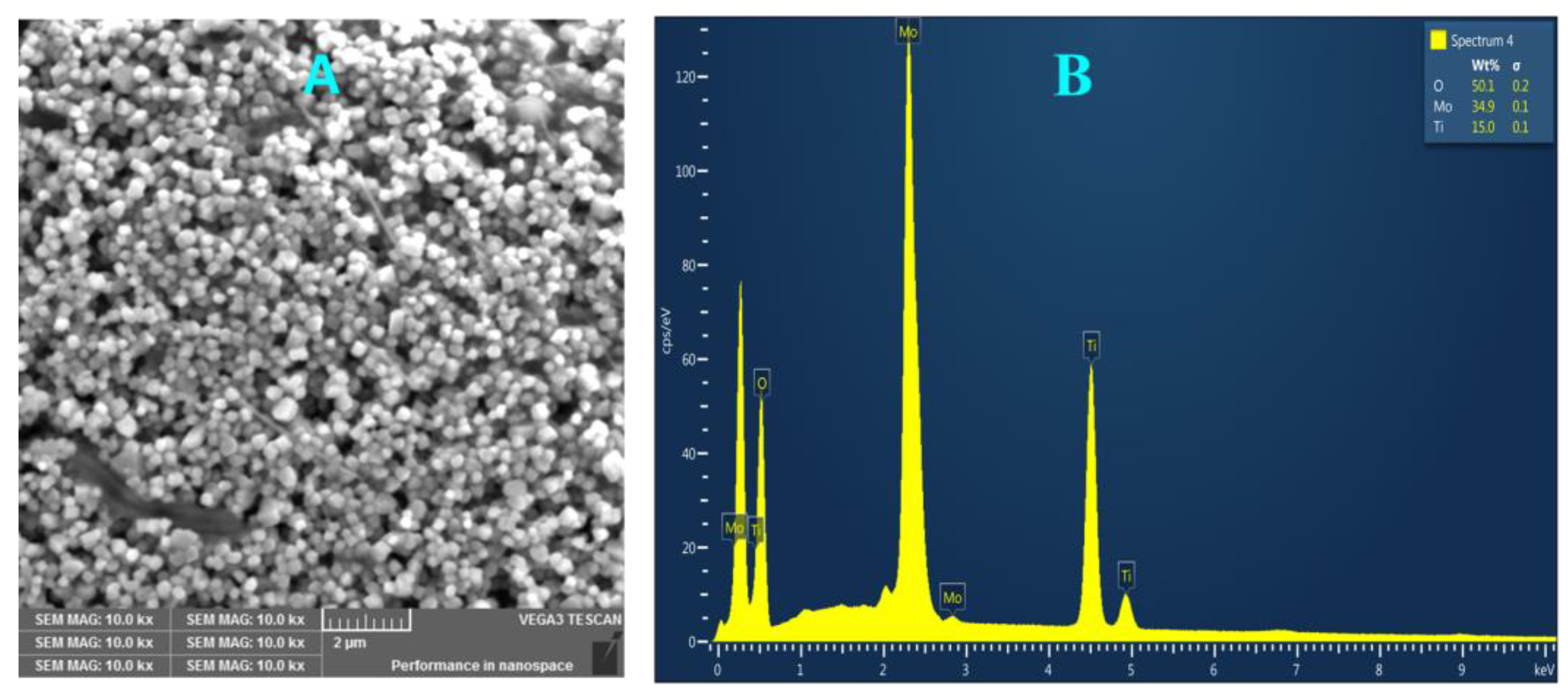
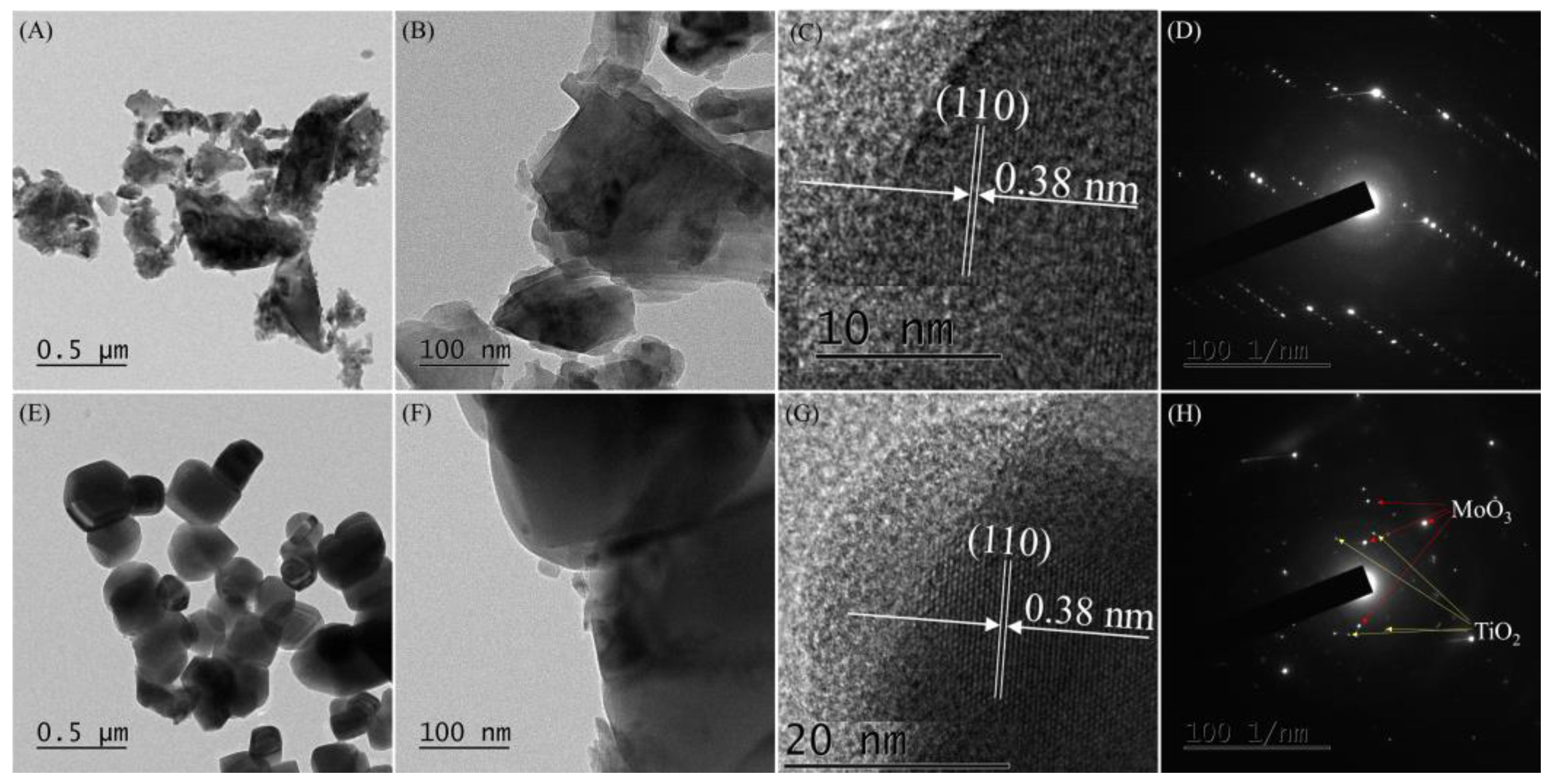

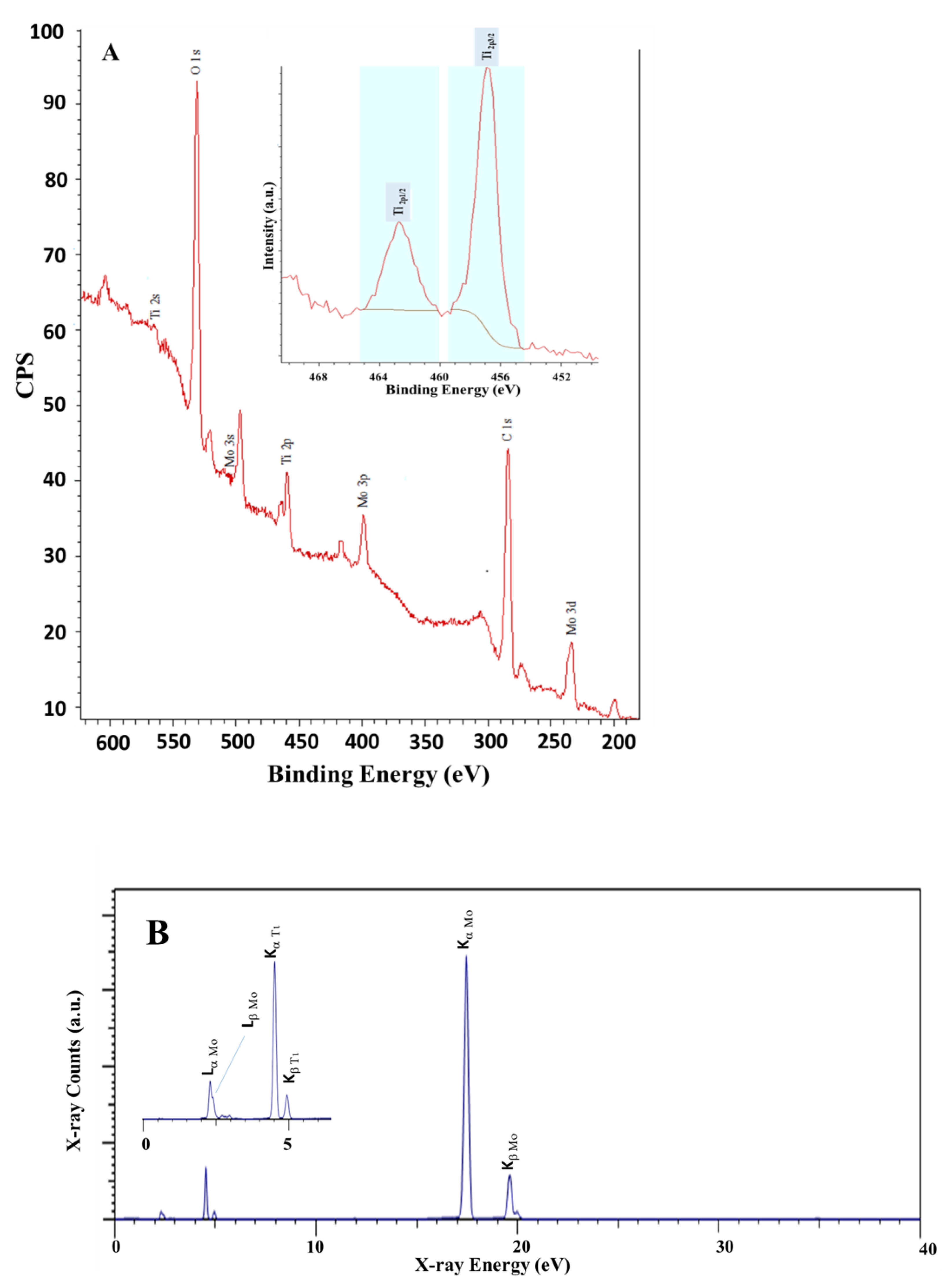
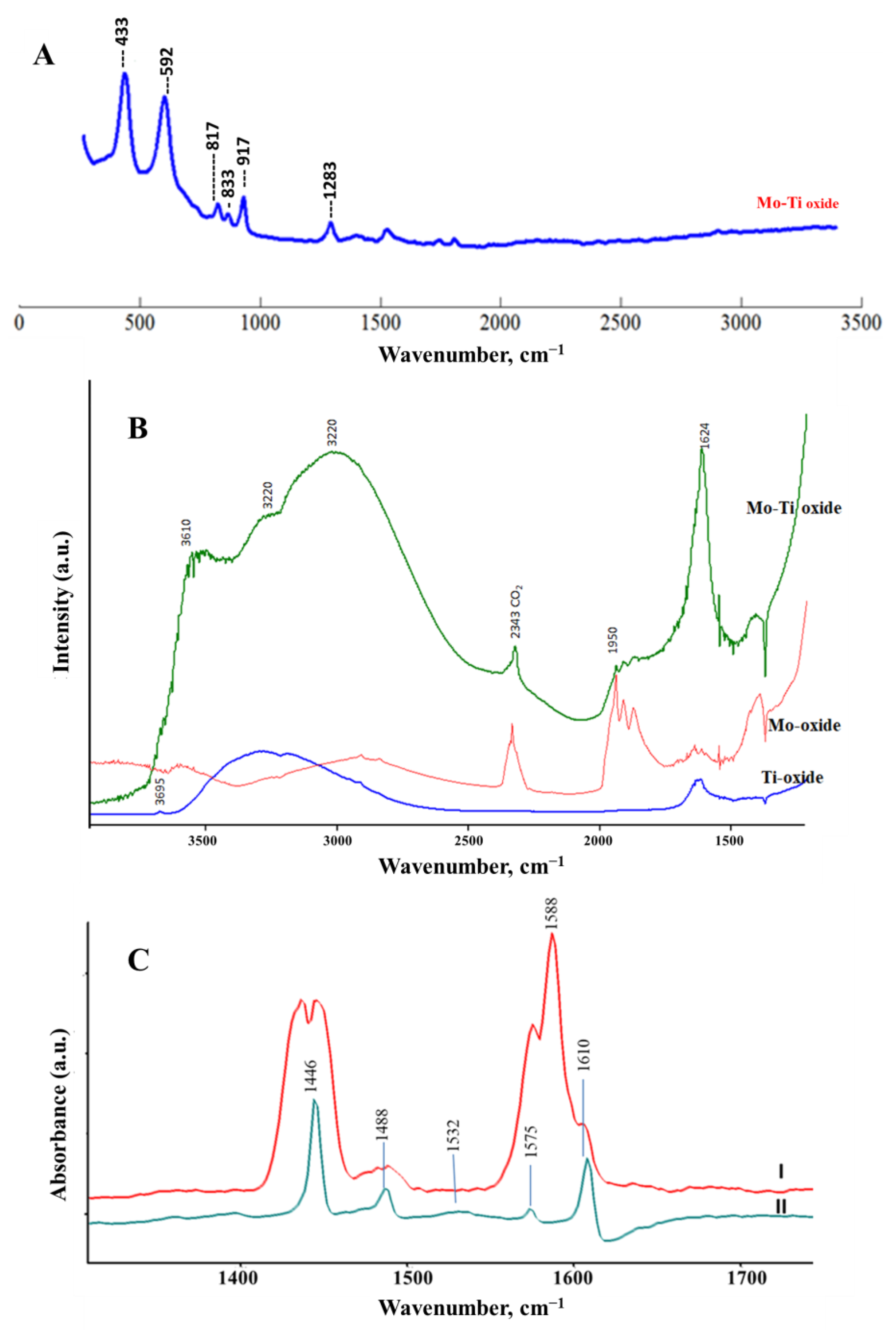


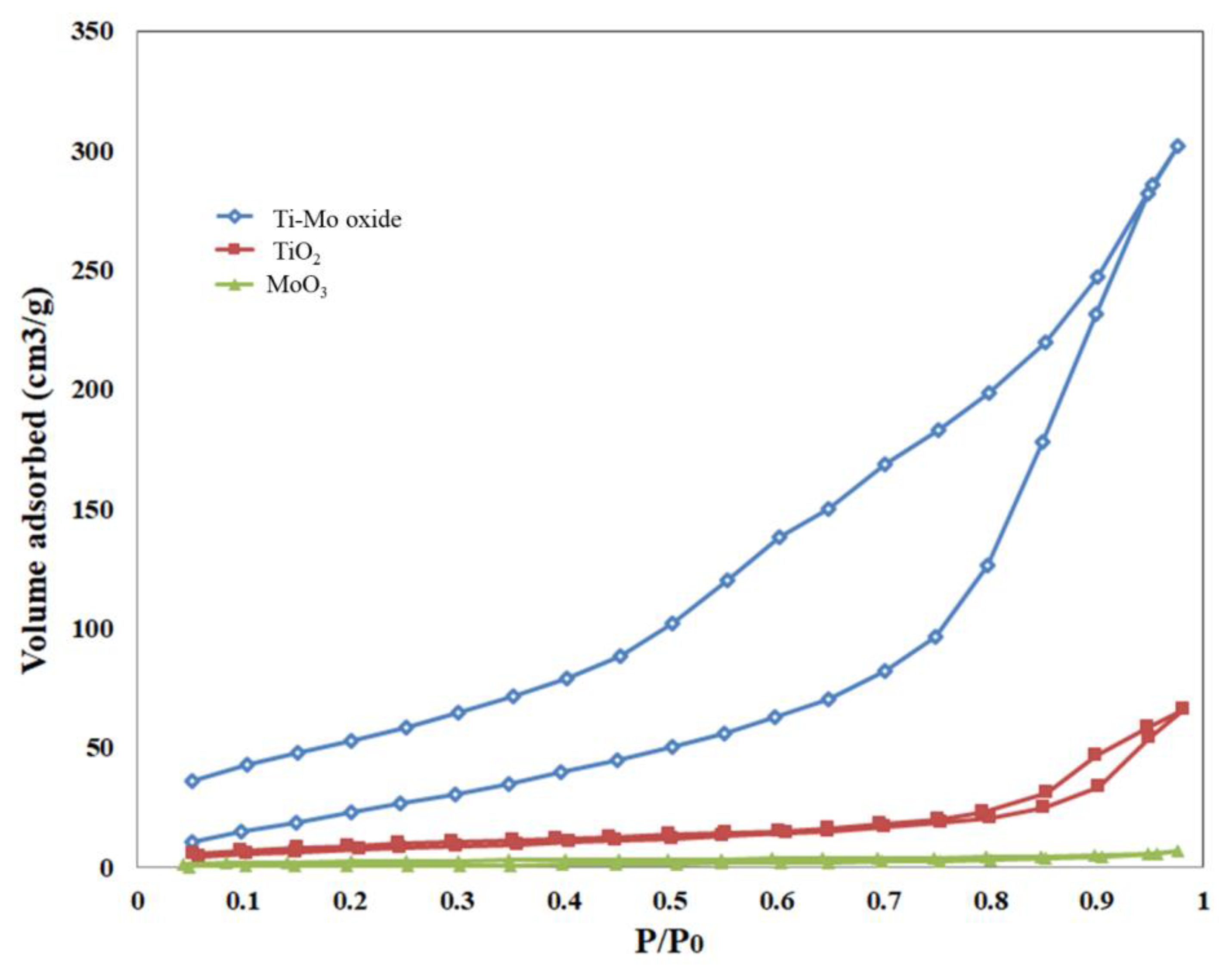
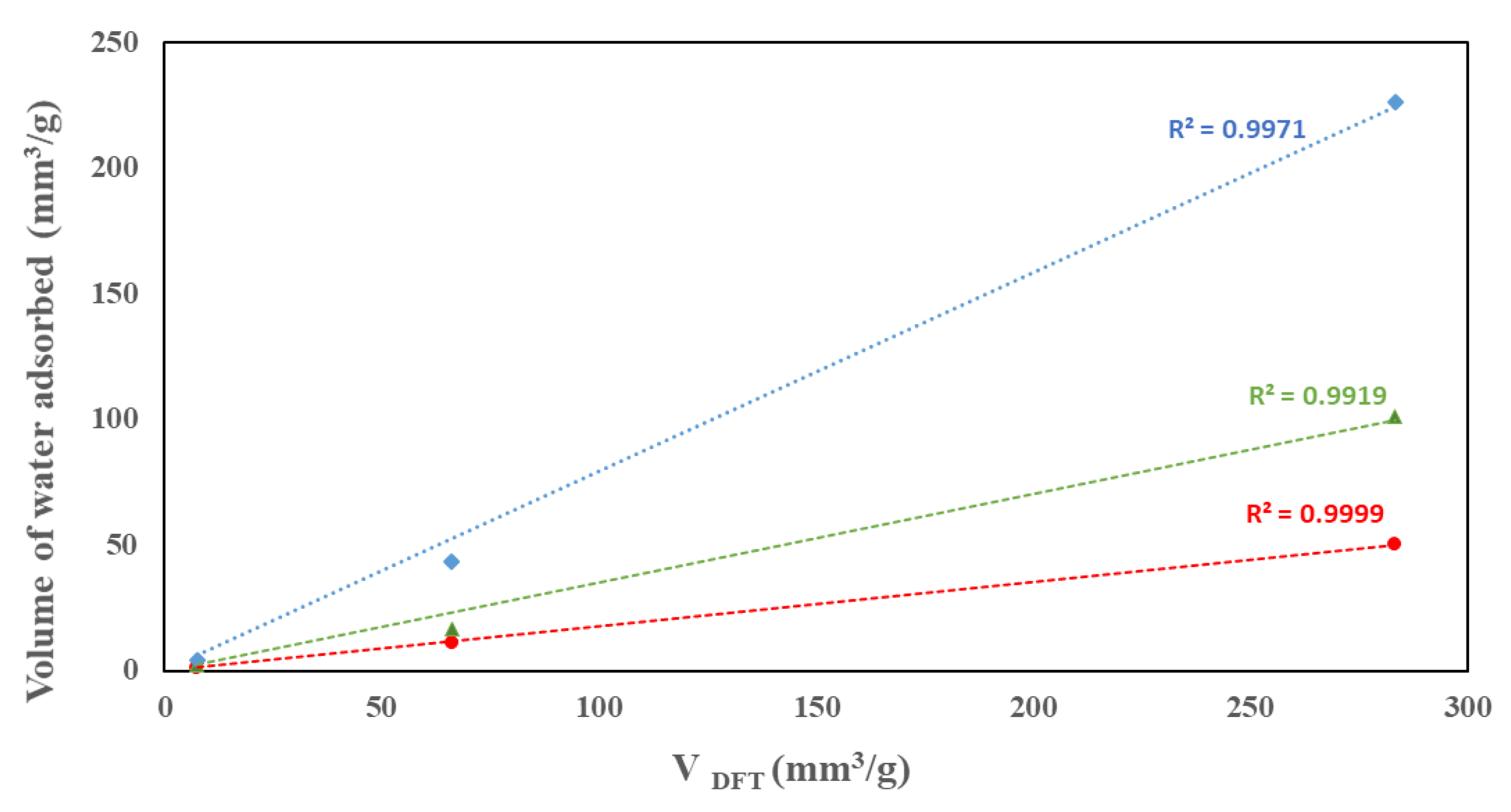

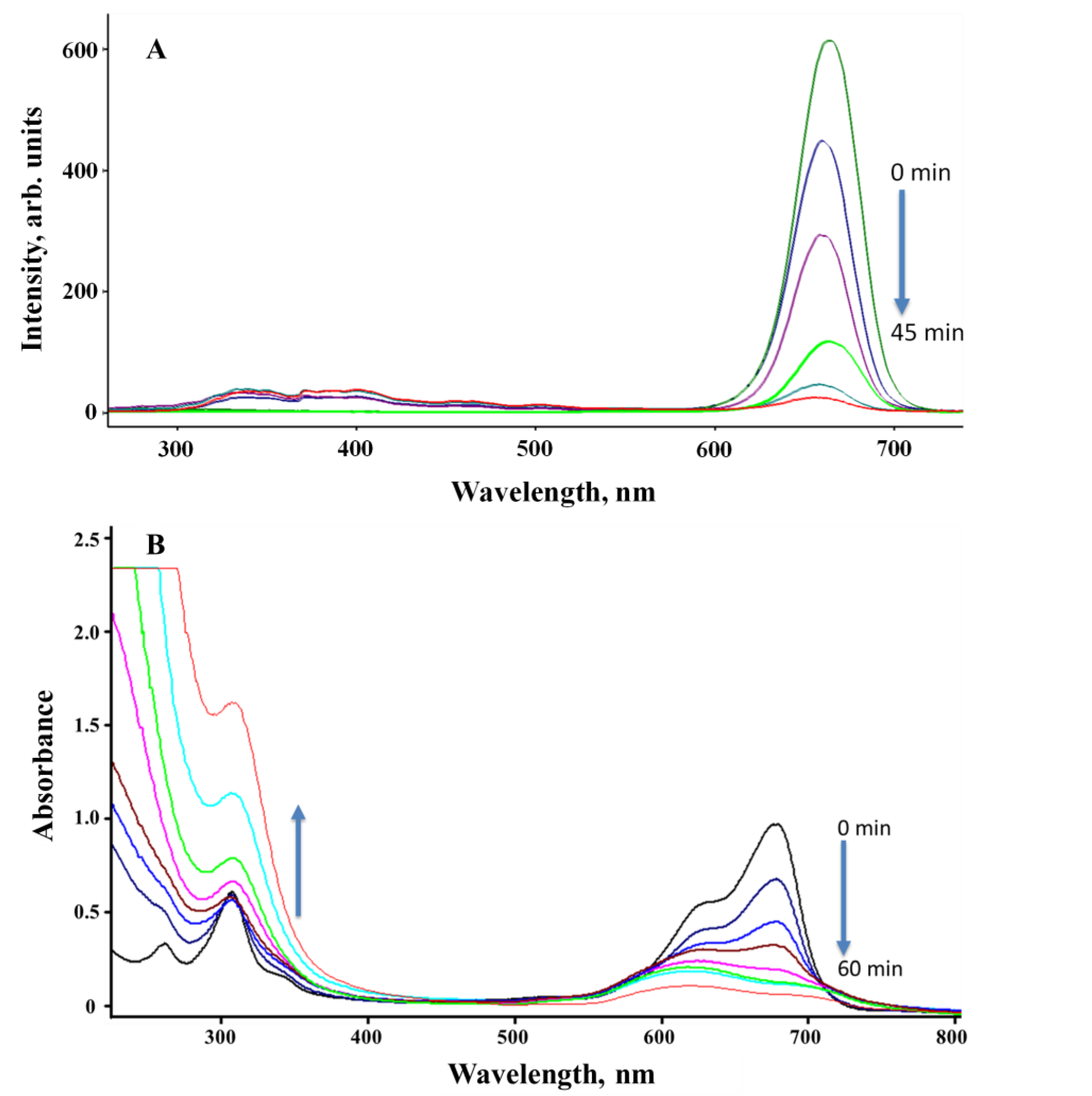
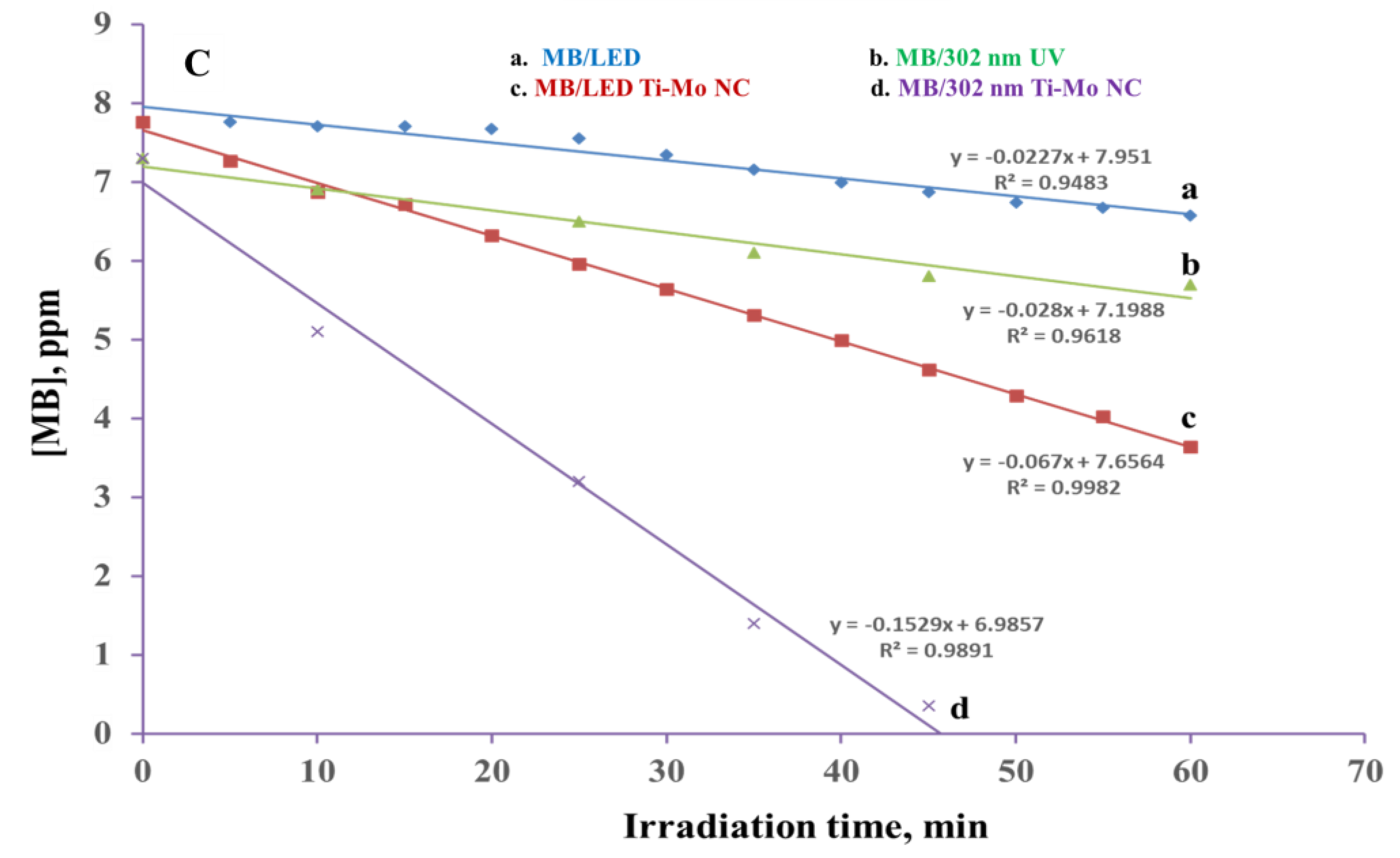


| Sample | V<10A (mm3/g) | Vmic (mm3/g) | Vt (mm3/g) | SBET (m2/g) | SDFT (m2/g) |
|---|---|---|---|---|---|
| MoO3 | 0.09 | 0.25 | 4.08 | 2.21 | 2.41 |
| TiO2 | 2.19 | 3.45 | 133.80 | 37.56 | 44.09 |
| Ti-Mo Oxide | 1.13 | 1.13 | 323.19 | 129.33 | 124.37 |
| p/po | Moisture Loading of Sorbents at STP (mg H2O/g Sorbent) | ||
|---|---|---|---|
| Ti-Mo Oxide | TiO2 | MoO3 | |
| 0.2 | 18.4 | 6.0 | 0.4 |
| 0.4 | 31.8 | 8.3 | 0.9 |
| 0.6 | 50.3 | 11.3 | 1.5 |
| 0.8 | 101.3 | 16.6 | 2.4 |
| 0.95 | 226.4 | 43.6 | 4.3 |
| Vt (mm3/g) | 283.4 | 66.1 | 7.5 |
Disclaimer/Publisher’s Note: The statements, opinions and data contained in all publications are solely those of the individual author(s) and contributor(s) and not of MDPI and/or the editor(s). MDPI and/or the editor(s) disclaim responsibility for any injury to people or property resulting from any ideas, methods, instructions or products referred to in the content. |
© 2023 by the authors. Licensee MDPI, Basel, Switzerland. This article is an open access article distributed under the terms and conditions of the Creative Commons Attribution (CC BY) license (https://creativecommons.org/licenses/by/4.0/).
Share and Cite
Abla, F.; Elsayed, Y.; Abu Farha, N.; Obaideen, K.; Mohamed, A.A.; Lee, H.; Han, C.; Egilmez, M.; Kanan, S. Fabrication of High Surface Area TiO2-MoO3 Nanocomposite as a Photocatalyst for Organic Pollutants Removal from Water Bodies. Catalysts 2023, 13, 362. https://doi.org/10.3390/catal13020362
Abla F, Elsayed Y, Abu Farha N, Obaideen K, Mohamed AA, Lee H, Han C, Egilmez M, Kanan S. Fabrication of High Surface Area TiO2-MoO3 Nanocomposite as a Photocatalyst for Organic Pollutants Removal from Water Bodies. Catalysts. 2023; 13(2):362. https://doi.org/10.3390/catal13020362
Chicago/Turabian StyleAbla, Fatima, Yehya Elsayed, Nedal Abu Farha, Khaled Obaideen, Ahmed A. Mohamed, Haesung Lee, Changseok Han, Mehmet Egilmez, and Sofian Kanan. 2023. "Fabrication of High Surface Area TiO2-MoO3 Nanocomposite as a Photocatalyst for Organic Pollutants Removal from Water Bodies" Catalysts 13, no. 2: 362. https://doi.org/10.3390/catal13020362
APA StyleAbla, F., Elsayed, Y., Abu Farha, N., Obaideen, K., Mohamed, A. A., Lee, H., Han, C., Egilmez, M., & Kanan, S. (2023). Fabrication of High Surface Area TiO2-MoO3 Nanocomposite as a Photocatalyst for Organic Pollutants Removal from Water Bodies. Catalysts, 13(2), 362. https://doi.org/10.3390/catal13020362











